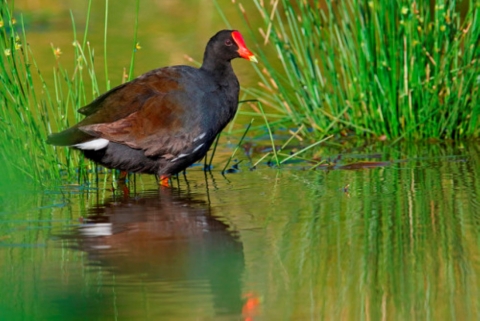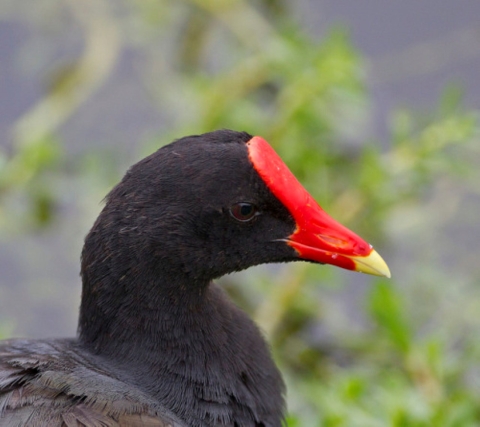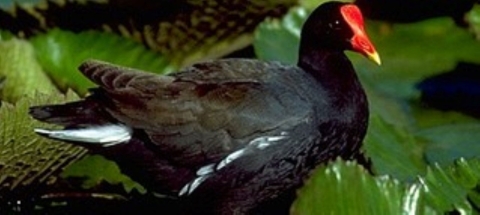Scientific Name: Gallinula chloropus sandvicensis
Hawaiian Name: ‘Alae ‘Ula
Common Name: Hawaiian Moorhen or Hawaiian Gallinule
Status: Endangered
According to Hawaiian legend, fire was brought to the people of Hawai’i by the gods. This delivery was not without a messenger though: the keeper of fire was tasked to a secretive waterbird. Marked by its red frontal shield, or forehead, this native moorhen earned its name: ‘alae ‘ula or “burnt forehead”.
But without its freshwater habitat, the ‘alae ‘ula may be lost forever along with its cultural symbolic presence. It was historically populous on all of the main Hawaiian islands except Kaho’olawe and Lāna’i. Now, it only is found in wetlands on O’ahu and Kaua’i. These populations are protected by ongoing efforts to restore and conserve Hawai’i’s wetland habitats like James Campbell NWR and Hanalei NWR, among many others.
Habitat and Range
The ‘alae ‘ula prefers lowland wetlands and river valleys, including habitats like: freshwater marshes, taro patches, irrigation ditches, reservoirs, and wet pastures. Due to a multitude of factors like habitat loss and predation, the ‘alae ‘ula now only resides on O’ahu and Kaua’i.
‘Alae ‘ula forage and nest in open water or shorelines less than 1 meter deep that have dense emergent vegetation, because they are more secretive. These vegetation mats provide food sources and platforms for their nests, which require standing freshwater. Therefore, most live in the Hanalei and Wailua river valleys of Kaua’i and between Hale‘iwa and Waimanalo on O’ahu. ‘Alae ‘ula are territorial and defend their wetland areas.
Diet and Life Cycle
Mollusks, insects, water plants or seeds, algae, and grasses make up most of their diet. A female may lay about 5 eggs in a clutch, which hatch after 19 to 22 days. Within a few hours, the chicks are able to walk and swim, but still need protection and food from their parents for several weeks. ‘Alae ‘ula nest year round, but mostly from March through August, depending on water levels and vegetation growth. Between June and September, ‘alae ‘ula molt for 25 days, during which they cannot fly.
Threats to the Species
Habitat loss is the biggest threat to these native waterbirds. This includes human impaction like:
- filling, dredging, and draining wetlands
- environmental contaminants from fuel or oil spills
- altered hydrology, or modifying wetlands for flood control, agriculture, or municipal usage
These threaten the habitats, reducing Hawai’i’s wetlands. Predators like feral dogs and cats, mongooses, rats, Cattle Egrets, bullfrogs, and Barn Owls are all introduced species which prey on chicks. The only natural predators are the Black-crowned Night Heron (Nycticorax nycticorax) and Short-eared Owl or Pueo (Asio flammeus). Some invasive plant species reduce the water from wetlands, and avian diseases like botulism affect ‘alae ‘ula.
Reason for Hope
Because many organizations like the U.S. Fish and Wildlife Service and Hawai’i Department of Land and Natural Resources collaborate, 23% of Hawai’i’s remaining coastal wetlands are protected. Not only are existing places being protected and restored, but more research is being done about these secretive birds so successful translocation and re-introduction of ‘alae ‘ula to other islands and wetlands may occur.
Where You Can See Them
- James Campbell National Wildlife Refuge
- Pearl Harbor National Wildlife Refuge
- Hanalei National Wildlife Refuge
- Hulēʻia National Wildlife Refuge
Article by Elena Fischer, External Affairs Kupu AmeriCorps Intern with the U.S. Fish and Wildlife Service.
###
The U.S. Fish and Wildlife Service works with others to conserve, protect, and enhance fish, wildlife, plants, and their habitats for the continuing benefit of the American people. For more information, visit www.fws.gov/pacificislands, or connect with us through any of these social media channels at https://www.facebook.com/PacificIslandsFWS, www.flickr.com/photos/usfwspacific/, https://medium.com/usfwspacificislands or www.twitter.com/USFWSPacific.






